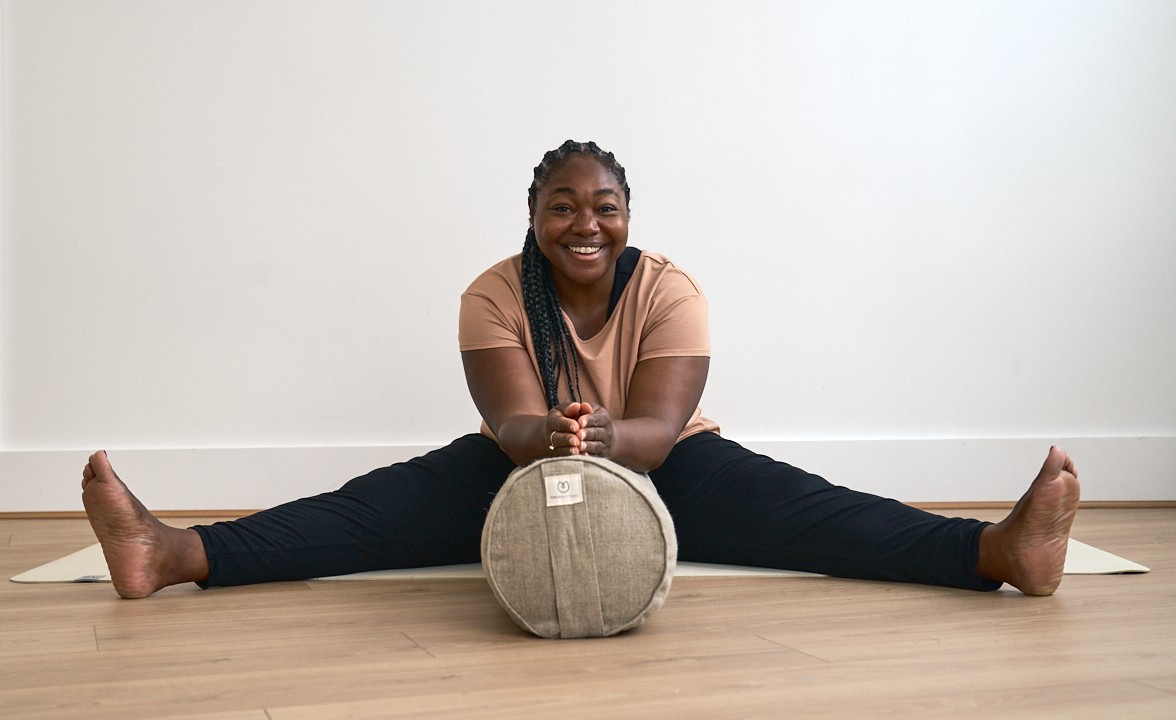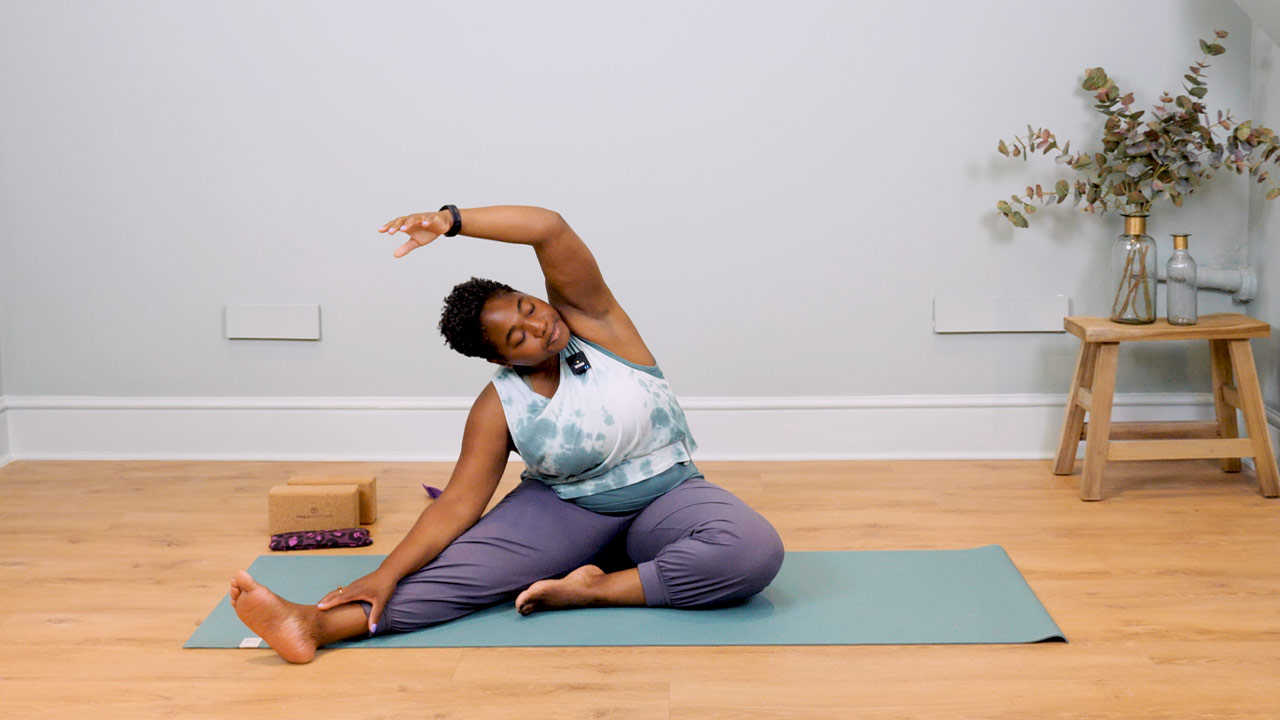Where are you from?
I was born in London. It’s the city where I grew up and still live.
How did yoga come into your life?
Via back pain. In my old job, working in television, I ended up experiencing persistent back pain from sitting a lot. Also, though I enjoyed my work it could be pretty stressful at times. It was a work colleague who suggested I try yoga for my back pain, so I began classes solely for the physical benefits. Yoga did indeed help my back pain, but I had not expected the wider impact it would have on my life. For instance, the stressful situations in my life did not disappear, but I found that the way I was able to view and deal with them shifted. I never imagined that a decade later I would be teaching yoga.
What do you offer to your community, through yoga?
Mainly the opportunity to slow down, to pause and to rest. These are things that so many of us don’t give ourselves the permission to do, yet they’re so needed.
Favourite yoga pose?
I can’t pick one, but it would certainly be a restorative yoga pose. I keep coming back to Savasana. In 2014, I embarked on something I called The 365 Savasana Project. I practised a restorative Savasana (supported with props) for twenty minutes, every day for a whole year. I wrote about it in OM Yoga Magazine at the time and the effect was transformative. This led to me beginning Savasana September, where every year I do the same thing throughout the month. Though this year, I’ve extended this for myself beyond the month of September.
Advice to new yogis?
A little bit consistently is more beneficial than doing a lot infrequently. Allow yourself to start small and you’ll be more likely to develop habits you can stick with. Mini-practices that can become part of your day are great. For instance, I’m a fan of intentionally pausing to bring awareness to my breath, meditating while sitting on the bus or train or while walking, and doing some yoga poses in bed when I wake up. I have lots of helpful tips in my book, Rest + Calm: Gentle yoga and mindful practices to nurture and restore yourself.
When it comes to asana, telling yourself you’re going to do one pose or one Sun salutation is usually enough to guide you into a longer practice, but if that one pose is all you do that day, that’s okay too. If you’re attending classes, whether online or in-person, seek out teachers you like to practice with. EkhartYoga has so many great teachers and classes that allow you to choose a practice according to your energy levels, your mood or how much time you have that day.
A little bit consistently is more beneficial than doing a lot infrequently.
Wind down with Paula
You’ll be guided through a slow, soothing, floor-based practice to help you ease physical and mental tension. Ideal for when you want to wind down at the end of the day but don’t feel like moving too much.
Recommended reading (yoga or not)?
I like both! I’ll do a shameless plug of my own book, Rest + Calm, which is grounded in restorative yoga and also includes lots of other practices and suggestions to help you soothe your nervous system and find some calm in your day-to-day life. There are so many books I could mention! A few of the books I’ve enjoyed over the last year or two include Radiant Rest, by Tracee Stanley, Dr Gail Parker’s books Restorative Yoga for Ethnic and Race-Based Stress and Trauma and Transforming Ethnic and Race-Based Traumatic Stress with Yoga. There’s also Menopause Yoga, by Petra Coveney, with whom I studied Menopause Yoga, and I like to re-visit Yoga for Emotional Balance, by Bo Forbes, who I’ve had the good fortune to study with and who also kindly wrote the foreword to my book. Non-yoga wise there’s Stronger, by Poorna Bell, and The Perimenopause Solution, by Dr Shahzadi Harper and Emma Bardwell.
As a child, what did you want to be when you grew up?
I was always really interested in stories and wanted to do something related to that, but I didn’t think that kind of work existed. So when people asked me what I wanted to be when I grew up I’d say something else. Before I started school at age four, my mother had already taught me how to read and write, so I would apparently read whatever I could get my hands on when I was little. I was also really into dancing – I did ballet, tap and modern jazz from the age of four to sixteen and this was one of my first forms of creative expression. It wasn’t until many years later that it sunk in that I had, in a roundabout way, ended up doing what I had wanted to as a child.
Surprising or little known fact about you?
This relates a little bit to my previous answer. People who’ve known me for a long time know this, but people who are only aware of me via yoga are usually surprised to learn that my background was in TV, having worked across a range of genres including daytime, documentary and children’s programming. I went on to spend ten years in comedy script development and production, which led to me doing some comedy scriptwriting for TV and radio. So, TV was my full-time job for longer than I’ve been teaching yoga. When I began teaching in 2011 I assumed that part of my life would be completely over, but I still do bits of script development here and there as well as my own writing (I’ve written a monthly column for OM Yoga Magazine for a decade). It’s that storytelling link again, so I feel I’ll always do something related to writing or storytelling whether it’s formally part of my work or not.
Closing words?
Remember to be kind to yourself as well as others. Your kindness should include you too.
Main image courtesy of YogaMatters.


